Wednesday, July 1st, 2020 by Julian Karsunky
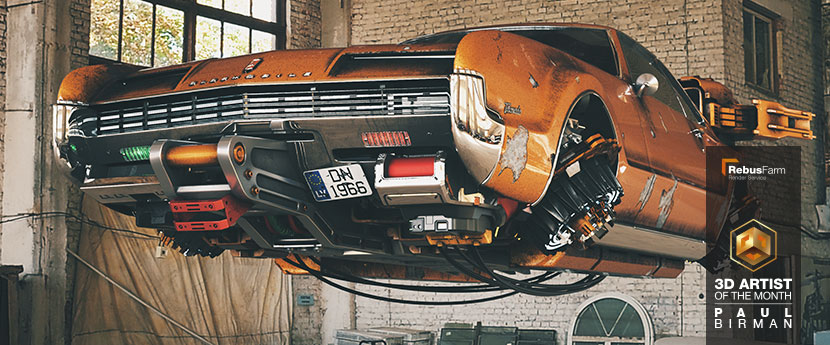
“Roads? Where we’re going, we don’t need roads!” Fasten your seatbelts, as Paul Birman, our July 2020 3D Artist of the Month, is about to take you for a wild ride. Combining three of his greatest passions – CGI, cars and Sci-Fi – Paul has created a series of iconic cars equipped with futuristic engines. Steadfast in his drive to advance his career, he challenged himself to produce a render every day, and didn’t hit the brakes until he hit 300 of these ‘everydays’.
Shift into gear as we discuss childhood influences, driving in the Latvian countryside and how to create an image in a day.
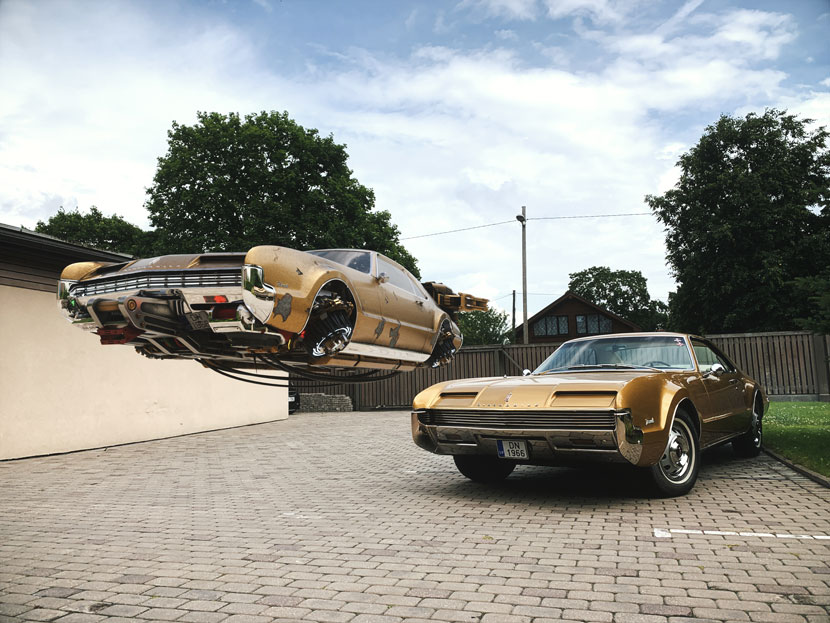 Original and 3D recreation: as a tribute to his friend and car owner, Paul adopted the license plate of the ‘Oldsmobile Toronado’.
Original and 3D recreation: as a tribute to his friend and car owner, Paul adopted the license plate of the ‘Oldsmobile Toronado’.
Hi Paul, thanks for joining us! To start things off, please introduce yourself to our readers.
Hey, hey! My name is Paul Birman, I’m a 33-year-old 3D artist from Riga, Latvia.
Do you recall your personal history with CGI? What made you interested in learning initially?
When I was nine years old and opened MS Paint for the first time (laughs). In all seriousness, it’s a tough question to answer. As a child, I used to love taking apart all sorts of toys and devices, just to find out how things worked. Interestingly enough, my parents weren’t angry about this, they probably figured I was driven by a healthy curiosity. You see, my father is an engineering programmer and my mom used to be a designer, so I think growing up in this environment laid the foundation for where I’m at today. Eventually, when I got my first LEGO sets, I went from breaking to building things.
When I was 12, my parents started sending me to programming courses. It was love at first sight, computer programming quickly replaced LEGO, and instead of bricks, I build stuff from code lines! Around a year later, I started to learn Photoshop. I’m the only one in the family who can’t draw by hand, but digitally, I could do whatever I want.
In my late teens, my father started to learn 3ds Max. He shared some books about 3D graphics and game development with me, and from this point on I wanted to put all my programming knowledge and graphic design into 3D. However, at the time CGI felt like quantum physics to me. Learning from books was very hard, and there were hardly any tutorials or online resources available back then. After a few attempts in Maya and 3ds Max, I’ve decided to stay in 2D graphics for the time being.
When and why did you then decide to pursuit a professional career as a 3D artist after all?
After graduating with a degree in programming, I worked in Latvian television, fixing computers and such. On the side, I was earning some extra money as a DJ and event organizer. As time passed, I grew more and more tired of crazy parties and my boring day job, so in 2012, I made a life-changing decision: I was finally going to learn 3D! As before, I started to learn 3ds Max but later switched to Cinema 4D, because the user interface is super friendly, there are a lot of online tutorials, and because many motion designers are using it. I spent about eight to ten hours every day in C4D, learning so much and in 2013, I returned to TV, but this time as a motion graphic designer. I went on to work for other companies as senior graphic designer, but the market in Latvia is rather small, so opportunities to make something in 3D were few and far between. This changed when I started creating and posting my ‘everydays’, the daily render works I share on Instagram.
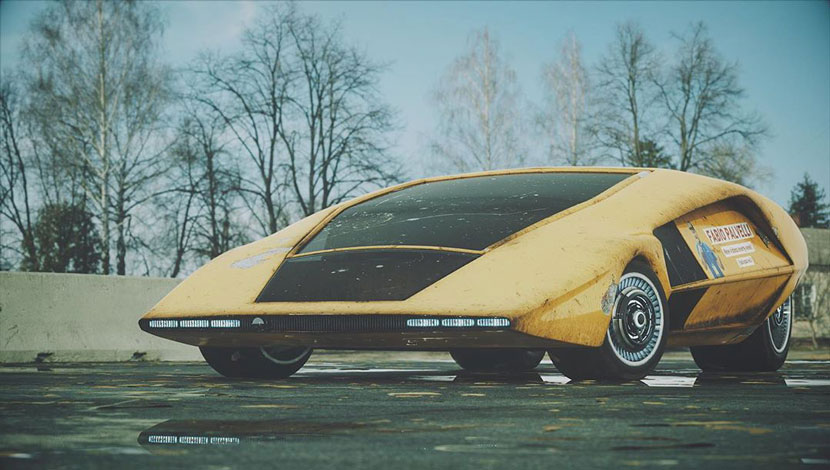 This car – a sneak peek for an upcoming tutorial – sports a futuristic look even without a propulsion engine.
This car – a sneak peek for an upcoming tutorial – sports a futuristic look even without a propulsion engine.
What training or education do you have?
Well, I’m a programmer on paper, but all I’ve learned in regards to 3D came from online tutorials, both free and paid, and a lot experimenting with the software. In fact, I’m still experimenting to this day, so if a program crashes, that’s normal for me (laughs).
Please tell us more about your current job situation – from what I understand you are exclusively freelancing at the moment?
Yes, as of April 1st, I am exclusively freelancing! I always wanted to go freelance, so I could put all my efforts into projects that I like, but never dared to take this step. But then the company I used to work for went bankrupt, and that was the kick in the rear I needed.
What services do you provide?
During the years I worked as a graphic designer, I gained a lot of experience in both digital design and printing. But now I prefer 3D animation, whether it’s fully animating products or adding 3D to real footage. Of course, I love 3D images a lot, concept art especially!
Who are your clients and target markets?
I don't have a specific target market yet. Every industry needs 3D from time to time, and at the moment, what’s most important for me is working on interesting projects.
As a result, my client base is pretty diverse: this year I worked on product presentations for start-ups and some VJ loops, did 3D visualization for ads, and am currently working on a project that combines 2D and 3D animation.
Shortly, I will have the chance to work with a well-known cinematographer from Los Angeles, who contacted me on Instagram and asked me to do a couple of short VFXs for his upcoming projects. This I’m really looking forward to, as it’ll get me closer to my biggest dream – to someday work on actual Hollywood movies!
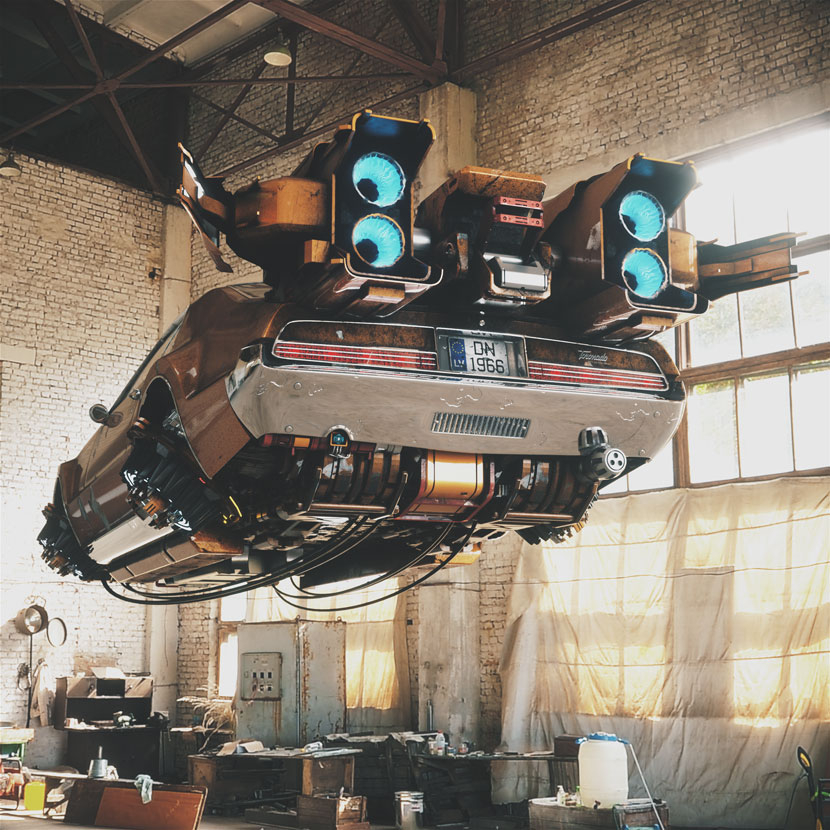 East Coast Customs: the rear view of the ‘Oldsmobile Toronado in 2966’ showcases Paul’s modifications.
East Coast Customs: the rear view of the ‘Oldsmobile Toronado in 2966’ showcases Paul’s modifications.
What are some of your personal career highlights thus far or projects you particularly enjoyed working on in the past?
Probably the biggest achievement of my 3D career was making a visualization for Lil Nas X's performance on the Ellen Degeneres Show.
To you personally, what are the biggest benefits and challenges of freelancing?
Learning to work from home was challenging at first. As a freelancer, you need to organize and evaluate your work and time properly in terms of efficiency and money. This includes knowing which jobs to take and how to not overextend.
You can generally earn more money, but there may also be months with little to no work available, so it is important to manage your income accordingly. At the same time, downtime also gives you the opportunity to work on interesting personal projects!
No one will deliver clients to you on a silver platter, so you need to master the art of self-marketing and put yourself out there through all means available.
How are you holding up in these trying times? Has the current crisis impeded your work?
Financially, my family is doing okay, as we thankfully managed to build up savings before the crisis hit. Still, the months from March to June were difficult. With two small children age two and four, I had to support my wife in keeping them busy during the day, since we weren’t comfortable sending them to kindergarten during a pandemic. So, the only time to get any work done was at night.
Two projects related to the music industry were pushed back to the end of the year. On the other hand, several new opportunities arose, as many businesses opened online stores during the crisis, which required advertising.
What is your favorite subject in CGI? For what reasons?
Everything! Well, I spend most of the time on texturing and lightning, that is very important to get “realistic” images.
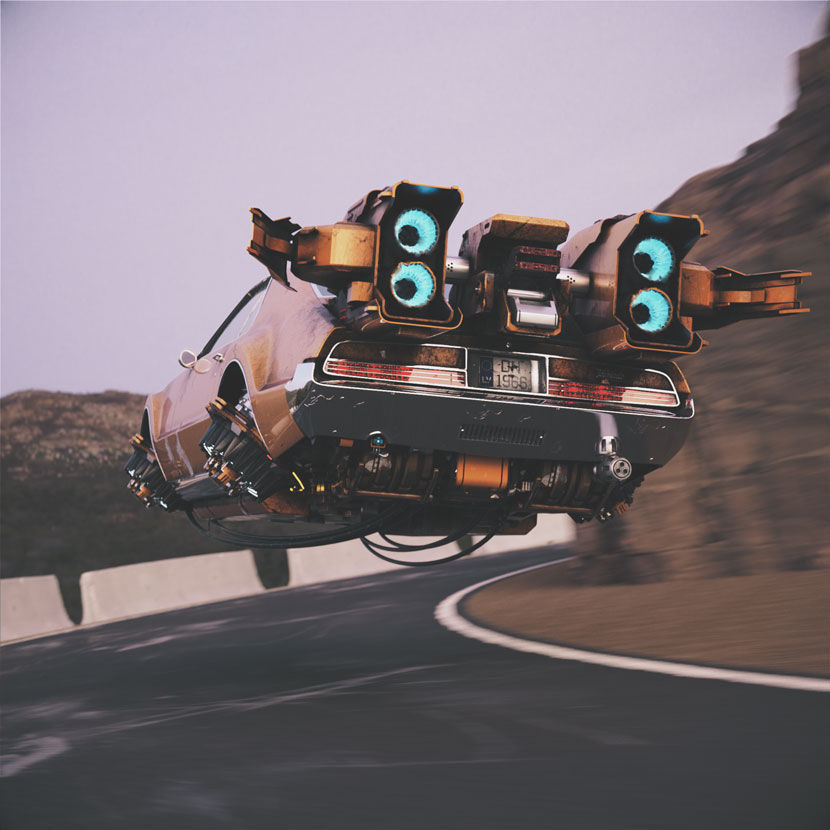 Taking it to the streets! Fun fact: the license plate is that of Paul’s friend’s Toronado, the car the image is based on.
Taking it to the streets! Fun fact: the license plate is that of Paul’s friend’s Toronado, the car the image is based on.
Let’s talk about your work in more detail, starting with the ‘Oldsmobile Toronado in 2966’, your futuristic rendition of a classic American sportscar. What was the main motivation for doing this piece? Was it a personal project or a commissioned work?
Commissioned work belongs to the clients, so 99% of the renders I post online are personal projects. That goes for the ‘Toronado’ as well, I made it for fun. My motivation was to learn some new skills. Since I love Sci-Fi, especially the juxtaposition of old and new, that's how the idea of giving these old, iconic cars a futuristic makeover came to be.
How long did it take you to complete the project?
It only took me two days, because most of the parts came from kitbashes I bought on Gumroad, ArtStation, TurboSquid and other portals. This was part of my everyday projects, I made the front of the car for the first day, and finished the back of the car for a second 'everyday'.
Now, some artists say that if you haven’t modeled everything yourself, you are not an artist. I totally disagree with that notion: buying premades and such supports other artists and can save you a lot of time, which you can then spend on composition, texturing and lightning. It’s the same with plug-ins: you could accomplish a lot of things without them, but you still use them to speed up your workflow. That said, I still create my own models for projects from time to time.
What were some of the challenges you had to overcome?
The biggest challenge is to combine all these Sci-Fi parts while keeping the beautiful shape of the car. Besides that, I’d say texturing – at the time, I wasn’t that good with the Octane Node Editor yet.
Why did you choose this particular car model? Do you have a personal history or a special fascination with the Toronado?
My friend bought a Toronado a while ago for restoration, and when he showed it to me, I fell in love with that car. Having already made some flying cars, I came up with the idea to give some of my friends’ cars the same treatment, and the Toronado was first on the list. I personally love to rebuild the cars in 3D, and it also makes my friends really excited!
Are you a bit of a car-nut in real life as well?
Oh yes, I love cars, I mean, who doesn’t? Until I was 18, I was spending my summers in the countryside, buying old cars for fun and driving up and down the country roads. At one point, I also owned an Audi 50 1972; unfortunately, I sold it for 30 Euro, which in hindsight was a huge mistake, that was a fantastic car.
I believe that every car has a soul and its own character, so I treat and care for it as a living creature. Now, I'm driving an Opel Insignia, an ordinary family car, which of course I tuned up just a bit to make it faster and more enjoyable to drive.
My dream car is the Chevrolet Corvette C3, I will definitely buy one eventually. I even bought a garage next to my home for that exact purpose two years ago. First, however, I bought all the high-end equipment I needed and built a studio at home. The Corvette is next on the list, though!
What software did you use to create this project? Any plug-ins you found particularly helpful?
Cinema 4D and OctaneRender, I also did most of the color correction in After Effects, just in case I decide to animate something later. For this particular project, I only used the Topowire plug-in for the hanging wires.
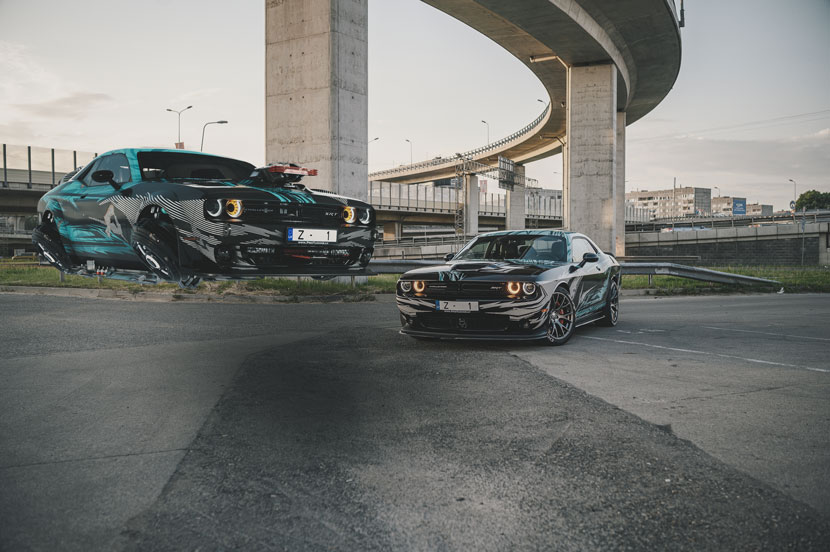 An image a day…futuristic cars are a staple in Paul’s everydays. Here, a Dodge Challenger takes flight next to its real-life counterpart.
An image a day…futuristic cars are a staple in Paul’s everydays. Here, a Dodge Challenger takes flight next to its real-life counterpart.
As you’ve mentioned, the ‘Oldsmobile Toronado’ is not the only car you outfitted with a futuristic propulsion engine. Looking through your portfolio, most of your personal work seems to exhibits a strong Sci-Fi aesthetic. Tell us more about your stylistic and visual preferences!
My father loves Sci-Fi, so I grew up watching mostly movies in that genre, which I think influenced me a lot. I’ve probably seen every Sci-Fi movie in existence, even those low-rated ones nobody remembers (laughs). For that reason, drawing on that aesthetic for my everydays was the obvious thing to do.
You have been doing and posting daily renders for a while now. Can you describe this routine of yours in more detail?
In 2019, I had the opportunity to partake in a Beeple workshop in Spain, which was an amazing experience and inspired me to work even harder and accomplish more in my 3D career. Mike Winkelmann pushed me to complete an image a day for 30 days straight, but I just kept going and made it to 300 before the crisis kicked in! To make it through these uncertain times, I decided to focus only on paid work for the foreseeable future.
Still, I feel bad that I had to stop, and I’ll definitely start over again eventually – my goal is to keep the everydays going for at least a full year straight!
In what ways have these everydays improved your overall work?
When I started doing the everydays, I improved my workflow significantly, learning tons of new things in the process. Images that would’ve taken me weeks to make before, I can now make in a single day.
The everydays gave my career a huge push, earning me exposure, awesome friends and new clients. I’m very grateful to Mike for motivating me to do this.
How do you produce an image in a day?
On weekdays, I sat down at the computer from 9 PM and finished before midnight every night. On weekends, I was putting in even more hours. And even though I put the everydays on hold, the routine is the same: I still work in Cinema4D daily, and I keep learning new stuff while doing so!
I imagine this sort of routine to require a lot of discipline. Where do you find the motivation and the creativity for ideas?
The first two weeks were super hard, but eventually it became as natural as taking a shower. Ideas came from random places, TV, the news, suggestions from friends and so on. Sometimes, I was searching for inspiration on Pinterest, ArtStation or Instagram. The hardest part was to create something unique and different from others artists’ everydays.
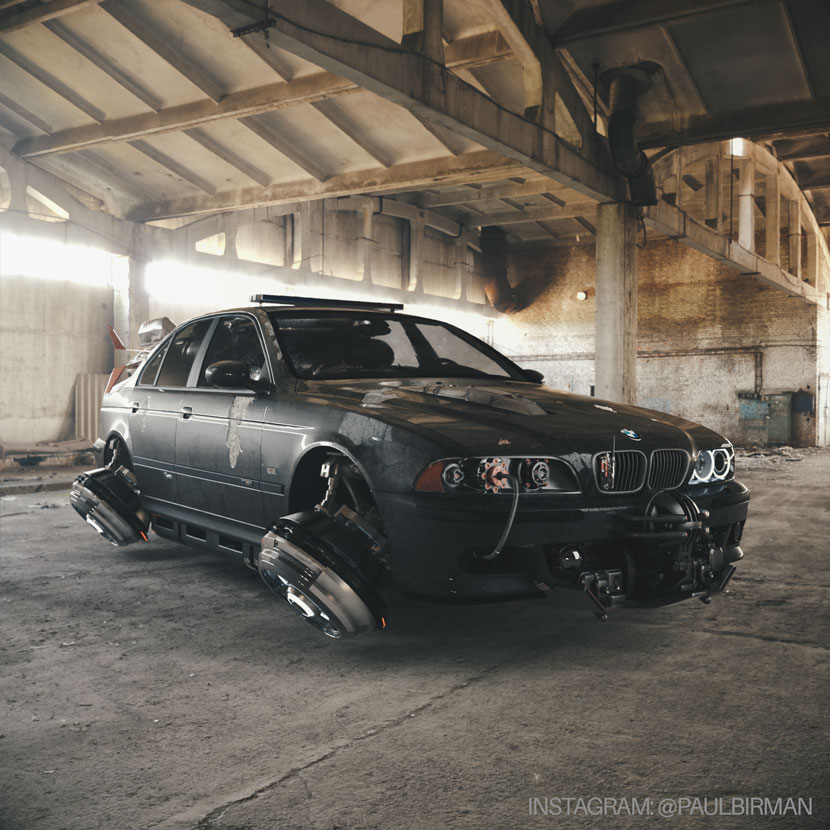 Paul gave this BMW M5 the Sci-Fi treatment as well. Is this what Paul meant when he told us he tuned the family car?
Paul gave this BMW M5 the Sci-Fi treatment as well. Is this what Paul meant when he told us he tuned the family car?
From your personal experience, what is some advice you would share with aspiring CG artists?
Learn, learn, learn! Every day, try to learn something new! Create your own projects and don’t be scared to post it everywhere on the internet. Artists need exposure – you could be a super skilled graphic designer, but if nobody knows about you, you won’t be able to get clients.
Always be critical of your work, and also be open to constructive criticism from others, as that will only help you to improve!
Have you used RebusFarm before? If so, please tell us about your previous experience! Is there anything you especially like about our service?
Yeah, during one of my previous jobs, I created a pretty demanding animation and we needed it to be rendered as soon as possible. I began researching render farms and ultimately, we chose RebusFarm. What I love most are the software and plug-in, thanks to which there are no headaches with sending scenes to the farm. We continued to use RebusFarm for other animations as well.
In closing, is there anything else you want to say? Any present or upcoming projects you’d like to mention?
First, I want to thank you for picking me as your 3D Artist of the Month, my birthday is in July, so this is an amazing, early present!
Project-wise, in January I started working on an animation about a futuristic race between two very well-known racing cars. I already made the cars, but haven’t posted them yet, since I don’t want to give anything away until the animation is finished. Hopefully, I will have free time in July to complete it. I believe the internet will go crazy once I post it, so please stay tuned.
That sounds amazing, we can hardly wait! Paul, thank you very much for taking the time and all the best in the future!
Keep up with Paul Birman and his work here:
HOW TO JOIN OUR MONTHLY CONTEST
You want to be our next featured 3D Artist of the Month and win 250 RenderPoints? Just visit our 3D Artist of the Month competition page and submit your entry. We'll choose the best image and contact the winner.
>> Read more articles on our blog
